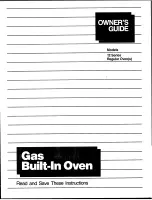
en
Tested for you in our cooking studio
34
for this reason. Try using the lower values at first. You
can increase the temperature next time if necessary.
The setting values are based on the assumption that
unstuffed, chilled, ready-to-roast poultry is placed into a
cold cooking compartment. By doing so, you can make
energy savings of up to 20 per cent. If you preheat the
oven, the indicated cooking times will be reduced by
several minutes.
In the table, you can find specifications for poultry with
default values for the weight. If you wish to cook heavier
poultry, use the lower temperature in every case. If
cooking multiple pieces, use the weight of the heaviest
piece as a reference for determining the cooking time.
The individual pieces should be approximately equal in
size.
A general rule: the larger the poultry is, the lower the
cooking temperature and the longer the cooking time.
Turn the poultry after approx.
^
to
Z
of the indicated
time.
Note:
Only use greaseproof paper that is suitable for
the selected temperature. Always cut greaseproof
paper to size.
Tips
■
For duck or goose, pierce the skin on the underside
of the wings. This allows the fat to run out.
■
If using duck breast, score the skin. Do not turn duck
breasts.
■
When you turn poultry, ensure that the breast side or
the skin side is underneath at first.
■
Poultry will turn out particularly crispy and brown if
you baste it towards the end of the roasting time with
butter, salted water or orange juice.
Remove unused accessories from the cooking
compartment. This will achieve the best possible
cooking results and energy savings of up to 20 per
cent.
Types of heating used:
■
ƒ
Top/bottom heating
■
‡
Circo-roasting
■
„
Circotherm intensive
■
ˆ
Full-surface grill
Meat
Your appliance offers you many heating types for
preparing meat. You can find the ideal settings for many
dishes in the settings tables.
Roasting and braising
Baste lean meat with fat as required or cover it with
strips of bacon.
Score the rind crosswise. If you turn the joint when
cooking, ensure that the rind is underneath at first.
When the joint is ready, turn off the oven and allow it to
rest for another 10 minutes in the cooking
compartment. This allows the meat juices to be better
distributed. Wrap the joint in aluminium foil if necessary.
The recommended standing time is not included in the
cooking time specified.
Roasting on the wire rack
On the wire rack, meat will become very crispy on all
sides.
Pour up to
^
litres of water into the universal pan,
depending on the size and type of the meat. Dripping
Dish
Accessories/cookware
Shelf posi-
tion
Type of
heating
Tempera-
ture in °C
Cooking
time in
mins.
Chicken
Chicken, 1 kg
Wire rack
2
‡
200-220
60-70
Chicken breast fillet, 150 g each (grilling)
Wire rack
4
ˆ
275*
15-20
Small chicken portions, 250 g each
Wire rack
3
‡
220-230
30-35
Chicken goujons, nuggets, frozen
Universal pan
3
„
190-210
20-25
Poulard, 1.5 kg
Wire rack
2
‡
200-220
70-90
Duck and goose
Duck, 2 kg
Wire rack
1
‡
180-200
90-110
Duck breast, 300 g each
Wire rack
3
‡
230-250
25-30
Goose, 3 kg
Wire rack
2
‡
160-180
120-150
Goose legs, 350 g each
Wire rack
2
‡
210-230
40-50
Turkey
Small turkey, 2.5 kg
Wire rack
2
‡
180-200
70-90
Turkey breast, boned, 1 kg
Cookware, covered
2
ƒ
240-260
80-100
Turkey thigh, with bone, 1 kg
Wire rack
2
‡
180-200
80-100
* Preheat for 5 mins
Содержание B17CS22 1 Series
Страница 1: ...en INSTRUCTION MANUAL Built in oven B17CS22 1...
Страница 2: ......
Страница 47: ......















































